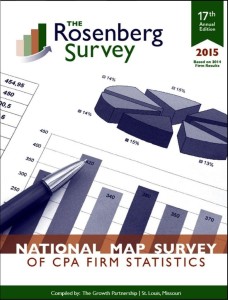The 2015 Rosenberg Survey: Top Ten Findings
 This was the 17th year of The Rosenberg Survey. Nearly 400 CPA firms participated from coast to coast, from both large and small population markets. Each year we analyze the results to identify key indicators that help us better understand CPA industry trends.
This was the 17th year of The Rosenberg Survey. Nearly 400 CPA firms participated from coast to coast, from both large and small population markets. Each year we analyze the results to identify key indicators that help us better understand CPA industry trends.
Here are the top 10 findings from the 2015 survey (reporting on 2014 data):
Revenue growth rate at 6.7% – surprisingly the same as last year. Organic growth is actually down a tad. The organic slowdown is explained by the loss of Baby Boomer clients, senior partners working past 65 but curtailing their practice development efforts, mergers channeling the focus of firms from organic growth to merger integration activities and limited ability to churn out more work due to limited staff capacity.
Profits are up a modest 2.6% – on the strength of billing rate increases and the 6.7% revenue growth. The metric “income per equity partner” (IPP) is being adversely affected by the huge number of mergers taking place, which tend to bring down the buyer’s IPP because the seller’s profitability is usually lower than the buyers’.
The merger market – the long term trend continues. Every year merger activity increases over the previous year, with no letup in sight. Mergers accounted for 30% of the industry’s 6.7% overall growth.
An amazing 51% of firms failed to average 1,500 billable hours from their staff. A bright person might observe, “Wait, you just told us that staff capacity is a huge problem, holding back revenue and profit growth. This seems inconsistent with the struggle firms are having with staff productivity.” Sorry, we don’t have a definitive answer. Anecdotally, we would observe that:
- Partners are still afraid to push their staff too hard for fear that they will leave.
- Staff are not being trained and mentored well because partners and other firm personnel receive little or no compensation for it.
- The capacity issue is not simply about having enough staff on board. It’s also having the right people at the right levels.
- Firms are abandoning efforts to recruit experienced staff in favor of hiring more entry level staff and training them in the firm’s own image.This reduces billable hours because more training is required.
The number of female partners continues to rise: This year, it was 17.0%, up from 16.4% last year. In 2006, it was 13.6%. The rise is slow, but it’s going in the right direction.
Professional staff turnover, at 17.1% and up from 15.4% last year, has reached the highest level since we began tracking this in 2004. Whenever the demand for labor is high and the supply is low, as it is today, staff react by jumping to other firms or totally outside the CPA industry.
The increasing age of CPA firm partners. This year, the number of partners over the age of 50 rose to 64.1%, up from 63.5% last year. It was 52% in 2005.
Ratio of highest to lowest compensated partners. For the first time ever, we noticed a slight narrowing of this ratio. We attribute this to the retirement of highly paid, rainmaking partners.
The average buy-in for new partners rose 7% to $144,000 from $135,000 last year.
Firms’ goodwill valuation for their internal partner buyout plans remained steady at 80% of revenue.
The Rosenberg Survey is widely acknowledged as the industry’s most authoritative MAP survey devoted to mid-sized CPA firms. Order your copy to learn how your firm’s metrics compare to your peers, and for more information on participating in next year’s survey Click Here.
1 Comments
Get our expertise delivered to your inbox.
I’m an experienced staff person at a CPA firm who is very ambitious and wants to be pushed technically as well as on the business development and soft skills side. I’m not being pushed and challenged enough. It’s a shame that partners hesitate to push their staff for fear they might leave. I want to be pushed.
I just don’t understand why CPA firm partners fail to see the value in mentoring and training, and why they don’t acknowledge the financial and non-financial rewards of investing more in their employees. As a future firm owner, I want to invest as much as I can in my employees’ professional development. I see it as a responsibility to have the best employees I possibly can.
I enjoy your blog and learn a lot from it. As a future firm owner or partner, I’ve been studying the most successful people I can find in the public accounting profession, and you’re in my top 10.